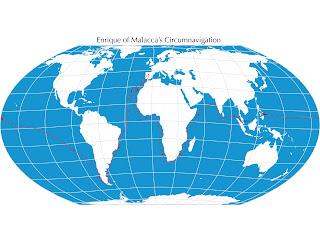 |
| Replica of Nao Victoria, one of Magellan's five ships. The Patagonians had never seen boats larger than canoes. |
A fortnight later we saw four of those giants without their arms for they had hidden them in certain bushes as the two whom we captured showed us. Each one was painted differently.
The captain-general kept two of them—the youngest and best proportioned—by means of a very cunning trick, in order to take them to Spagnia. Had he used any other means [than those he employed], they could easily have killed some of us.
The trick that he employed in keeping them was as follows. He gave them many knives, scissors, mirrors, bells, and glass beads; and those two having their hands filled with the said articles, the captain-general had two pairs of iron manacles brought, such as are fastened on the feet.
He made motions that he would give them to the giants, whereat they were very pleased since those manacles were of iron, but they did not know how to carry them. They were grieved at leaving them behind, but they had no place to put those gifts; for they had to hold the skin wrapped about them with their hands. The other two giants wished to help them, but the captain refused.
Seeing that they were loth to leave those manacles behind, the captain made them a sign that he would put them on their feet, and that they could carry them away. They nodded assent with the head. Immediately, the captain had the manacles put on both of them at the same time.
When our men were driving home the cross bolt, the giants began to suspect something, but the captain assuring them, however, they stood still.
When they saw later that they were tricked, they raged like bulls, calling loudly for Setebos to aid them. With difficulty could we bind the hands of the other two, whom we sent ashore with nine of our men, in order that the giants might guide them to the place where the wife of one of the two whom we had captured was; for the latter expressed his great grief at leaving her by signs so that we understood [that he meant] her.
While they were on their way, one of the giants freed his hands, and took to his heels with such swiftness that our men lost sight of him. He went to the place where his associates were, but he did not find [there] one of his companions, who had remained behind with the women, and who had gone hunting.
He immediately went in search of the latter, and told him all that had happened. The other giant endeavored so hard to free himself from his bonds, that our men struck him, wounding him slightly on the head, whereat he raging led them to where the women were.
Gioan Cavagio, the pilot and commander of those men, refused to bring back the woman that night, but determined to sleep there, for night was approaching. The other two giants came, and seeing their companion wounded, hesitated, but said nothing then.
But with the dawn, they spoke to the women, [whereupon] they immediately ran away (and the smaller ones ran faster than the taller), leaving all their possessions behind them.
Two of them turned aside to shoot their arrows at our men. The other was leading away those small animals of theirs in order to hunt. Thus fighting, one of them pierced the thigh of one of our men with an arrow, and the latter died immediately. When the giants saw that, they ran away quickly.
Our men had muskets and crossbows, but they could never hit any of the giants, [for] when the latter fought, they never stood still, but leaped hither and thither.
Our men buried their dead companion, and burned all the possessions left behind by the giants. Of a truth those giants run swifter than horses and are exceedingly jealous of their wives.
Part 1. First Contact Patagonia: Magellan and the Patagonians, Pigafetta 1
Part 2. Giants and Guanacos: Magellan and the Patagonians, Pigafetta 2
Part 3. Giant John: Magellan and the Patagonians, Pigafetta 3

